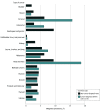Substance Use Disorders Among US Adult Cancer Survivors
- PMID: 38206609
- PMCID: PMC10784996
- DOI: 10.1001/jamaoncol.2023.5785
Substance Use Disorders Among US Adult Cancer Survivors
Abstract
Importance: Some individuals are predisposed to cancer based on their substance use history, and others may use substances to manage cancer-related symptoms. Yet the intersection of substance use disorder (SUD) and cancer is understudied. Because SUD may affect and be affected by cancer care, it is important to identify cancer populations with a high prevalence of SUD, with the goal of guiding attention and resources toward groups and settings where interventions may be needed.
Objective: To describe the cancer type-specific prevalence of SUD among adult cancer survivors.
Design, setting, and participants: This cross-sectional study used data from the annually administered National Survey on Drug Use and Health (NSDUH) for 2015 through 2020 to identify adults with a history of solid tumor cancer. Substance use disorder was defined as meeting at least 1 of 4 Diagnostic and Statistical Manual of Mental Disorders (Fourth Edition) criteria for abuse or at least 3 of 6 criteria for dependence.
Main outcomes and measures: Per NSDUH guidelines, we made adjustments to analysis weights by dividing weights provided in the pooled NSDUH data sets by the number of years of combined data (eg, 6 for 2015-2020). The weighted prevalence and corresponding SEs (both expressed as percentages) of active SUD (ie, within the past 12 months) were calculated for respondents with any lifetime history of cancer and, in secondary analyses, respondents diagnosed with cancer within 12 months prior to taking the survey. Data were analyzed from July 2022 to June 2023.
Results: This study included data from 6101 adult cancer survivors (56.91% were aged 65 years or older and 61.63% were female). Among lifetime cancer survivors, the prevalence of active SUD was 3.83% (SE, 0.32%). Substance use disorder was most prevalent in survivors of head and neck cancer (including mouth, tongue, lip, throat, and pharyngeal cancers; 9.36% [SE, 2.47%]), esophageal and gastric cancer (9.42% [SE, 5.51%]), cervical cancer (6.24% [SE, 1.41%]), and melanoma (6.20% [SE, 1.34%]). Alcohol use disorder was the most common SUD (2.78% [SE, 0.26%]) overall and in survivors of head and neck cancer, cervical cancer, and melanoma. In survivors of esophageal and gastric cancers, cannabis use disorder was the most prevalent SUD (9.42% [SE, 5.51%]). Among respondents diagnosed with cancer in the past 12 months, the overall prevalence of active SUD was similar to that in the lifetime cancer survivor cohort (3.81% [SE, 0.74%]). However, active SUD prevalence was higher in head and neck (18.73% [SE, 10.56%]) and cervical cancer survivors (15.70% [SE, 5.35%]). The distribution of specific SUDs was different compared with that in the lifetime cancer survivor cohort. For example, in recently diagnosed head and neck cancer survivors, sedative use disorder was the most common SUD (9.81% [SE, 9.17%]).
Conclusions and relevance: Findings of this study suggest that SUD prevalence is higher among survivors of certain types of cancer; this information could be used to identify cancer survivors who may benefit from integrated cancer and SUD care. Future efforts to understand and address the needs of adult cancer survivors with comorbid SUD should prioritize cancer populations in which SUD prevalence is high.
Conflict of interest statement
Figures
References
-
- Wangensteen T, Hystad J. A comprehensive approach to understanding substance use disorder and recovery: former patients’ experiences and reflections on the recovery process four years after discharge from SUD treatment. J Psychosoc Rehabil Ment Health. 2022;9(1):45-54. doi:10.1007/s40737-021-00233-9 - DOI - PMC - PubMed
-
- Singh SA, Moreland RA, Fang W, et al. . Compassion inequities and opioid use disorder: a matched case-control analysis examining inpatient management of cancer-related pain for patients with opioid use disorder. J Pain Symptom Manage. 2021;62(3):e156-e163. doi:10.1016/j.jpainsymman.2021.05.002 - DOI - PMC - PubMed
-
- Substance Abuse and Mental Health Services Administration . 2021. National Survey on Drug Use and Health (NSDUH). Accessed June 1, 2022. https://www.samhsa.gov/data/release/2021-national-survey-drug-use-and-he... - PubMed
-
- Keyes KM, Rutherford C, Hamilton A, et al. . What is the prevalence of and trend in opioid use disorder in the United States from 2010 to 2019? Using multiplier approaches to estimate prevalence for an unknown population size. Drug Alcohol Depend Rep. 2022;3:100052. doi:10.1016/j.dadr.2022.100052 - DOI - PMC - PubMed
Publication types
MeSH terms
Grants and funding
LinkOut - more resources
Full Text Sources
Medical
Miscellaneous


